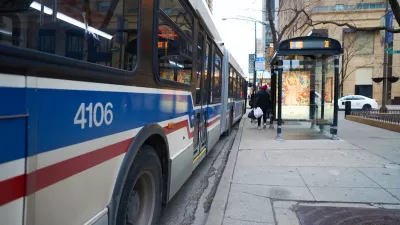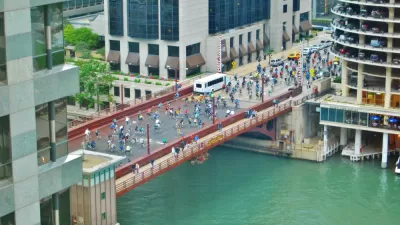A report on the progress so far on the Navy Pier Flyover, a half-mile bridge for recreational users on Chicago's Lakefront Trail.
John Hilkevitch begins an article about the development of Chicago's Lakefront trail with a provocative question:
"The original section of the Great Wall of China went up in about 20 years. The 110-story Sears Tower was erected in only three years. So how long does it take to build a roughly 2,700-foot-long pedestrian bridge in Chicago?"
The cause for the consternation at the heart of the article is the $60 million Navy Flier Flyover:
"When completed in 2018, the 16-foot-wide bridge will eliminate close encounters between vehicles and nonmotorized traffic by permanently rerouting one of the most heavily used sections of the lakefront trail away from the lower-level sidewalk along the Lake Shore Drive bridge near Lake Point Tower. Bikers, pedestrians and others will no longer cross Grand Avenue and Illinois Street at street level."
As Hilkevitch details the project, scheduled to be completed in three phases, and the safety concerns raised by users in its current state. Hilkevitch also answers the original question above: at least four years, if the target completion date is met after a January 2014 launch.
FULL STORY: Lakefront trail project on a slow and risky path

Planetizen Federal Action Tracker
A weekly monitor of how Trump’s orders and actions are impacting planners and planning in America.

San Francisco's School District Spent $105M To Build Affordable Housing for Teachers — And That's Just the Beginning
SFUSD joins a growing list of school districts using their land holdings to address housing affordability challenges faced by their own employees.

The Tiny, Adorable $7,000 Car Turning Japan Onto EVs
The single seat Mibot charges from a regular plug as quickly as an iPad, and is about half the price of an average EV.

Seattle's Plan for Adopting Driverless Cars
Equity, safety, accessibility and affordability are front of mind as the city prepares for robotaxis and other autonomous vehicles.

As Trump Phases Out FEMA, Is It Time to Flee the Floodplains?
With less federal funding available for disaster relief efforts, the need to relocate at-risk communities is more urgent than ever.

With Protected Lanes, 460% More People Commute by Bike
For those needing more ammo, more data proving what we already knew is here.
Urban Design for Planners 1: Software Tools
This six-course series explores essential urban design concepts using open source software and equips planners with the tools they need to participate fully in the urban design process.
Planning for Universal Design
Learn the tools for implementing Universal Design in planning regulations.
Smith Gee Studio
City of Charlotte
City of Camden Redevelopment Agency
City of Astoria
Transportation Research & Education Center (TREC) at Portland State University
US High Speed Rail Association
City of Camden Redevelopment Agency
Municipality of Princeton (NJ)





























